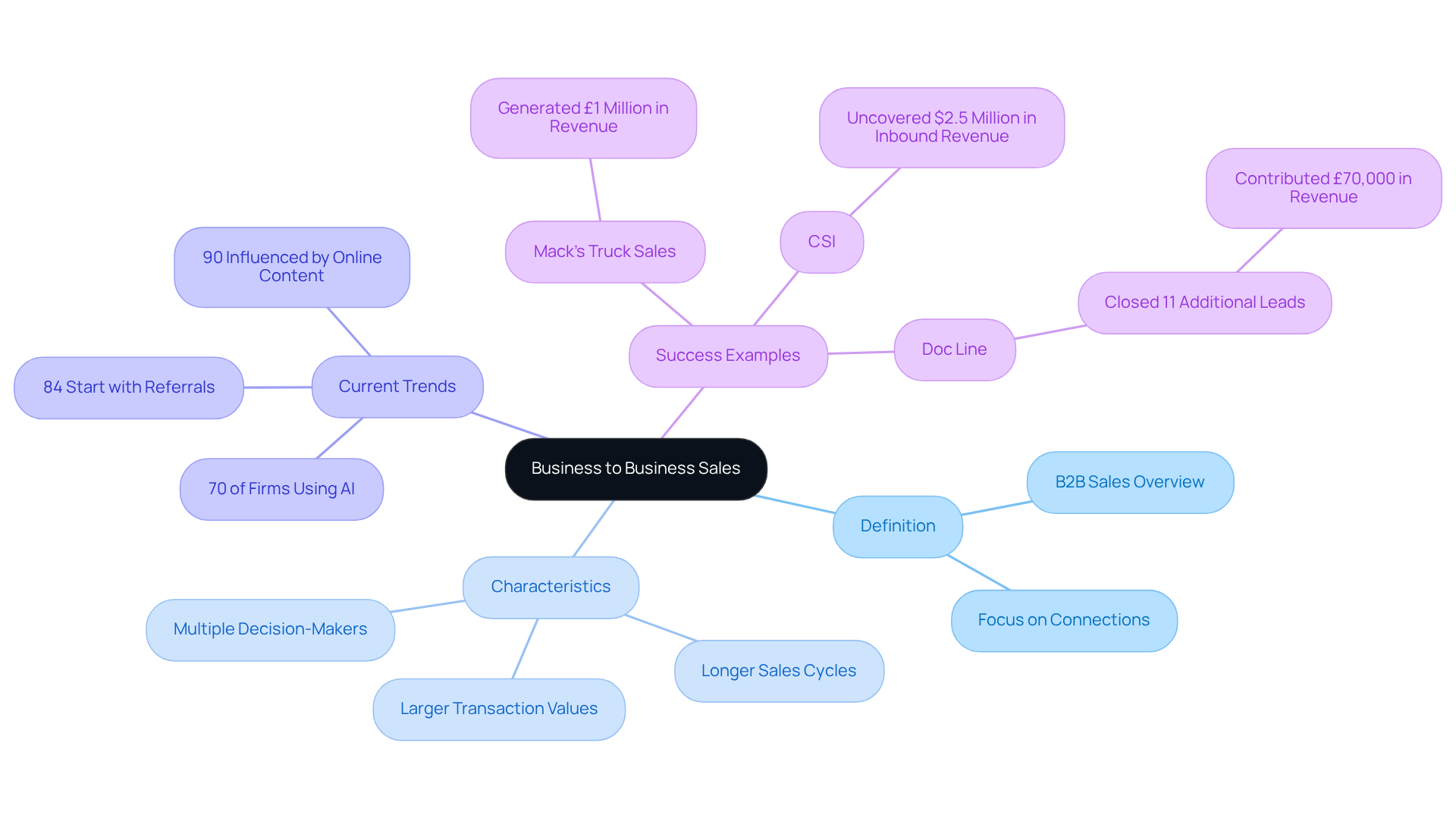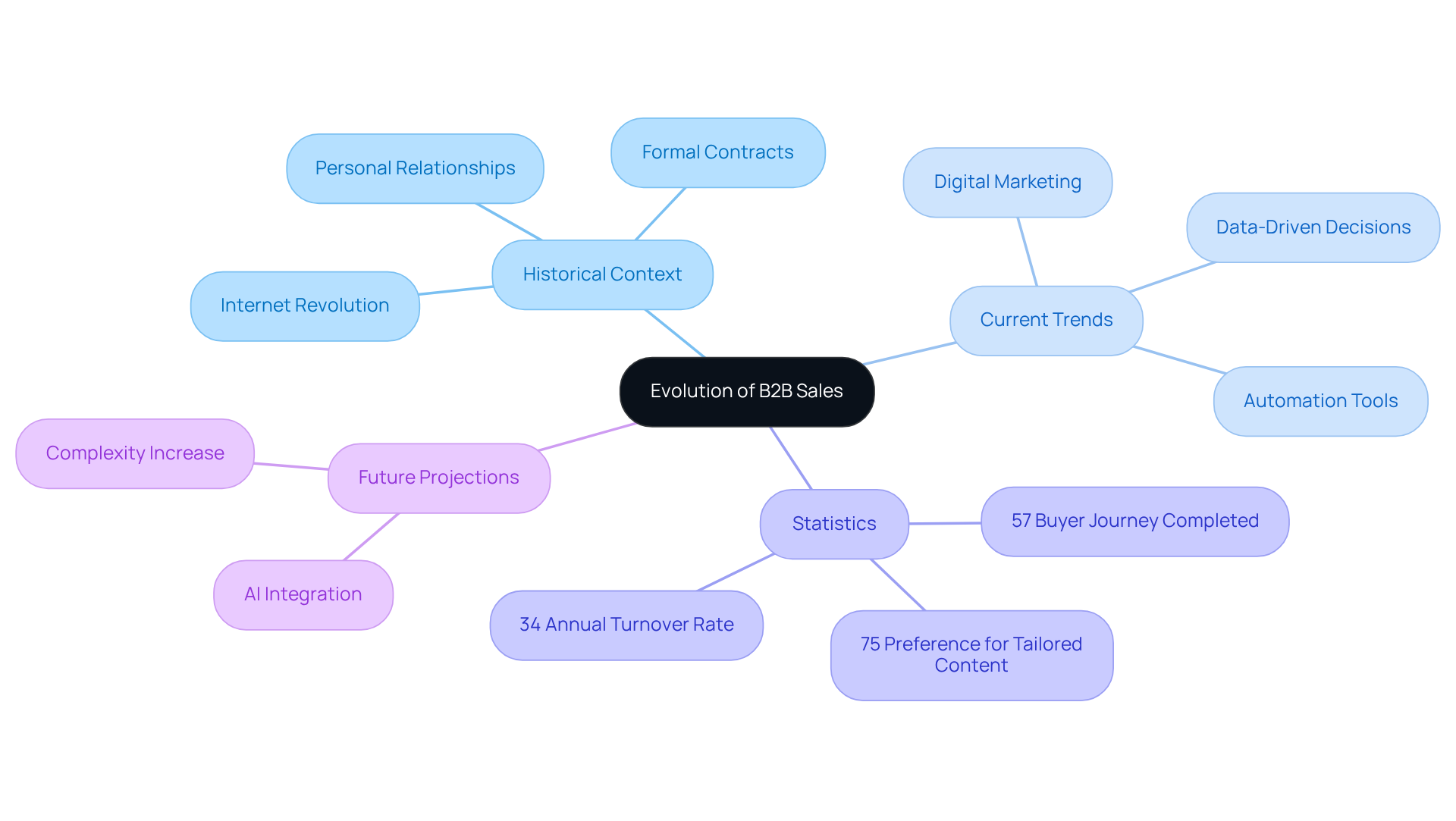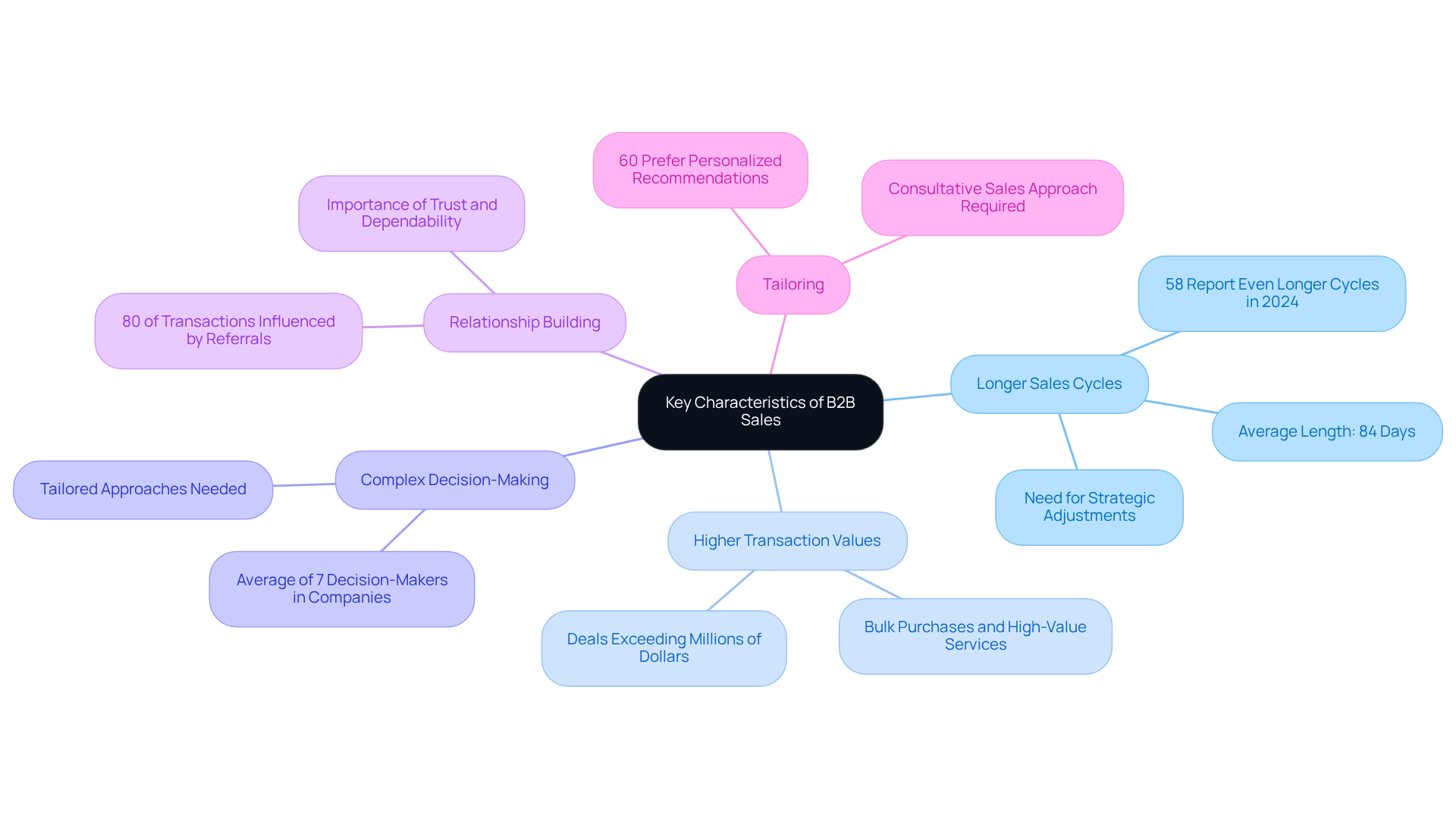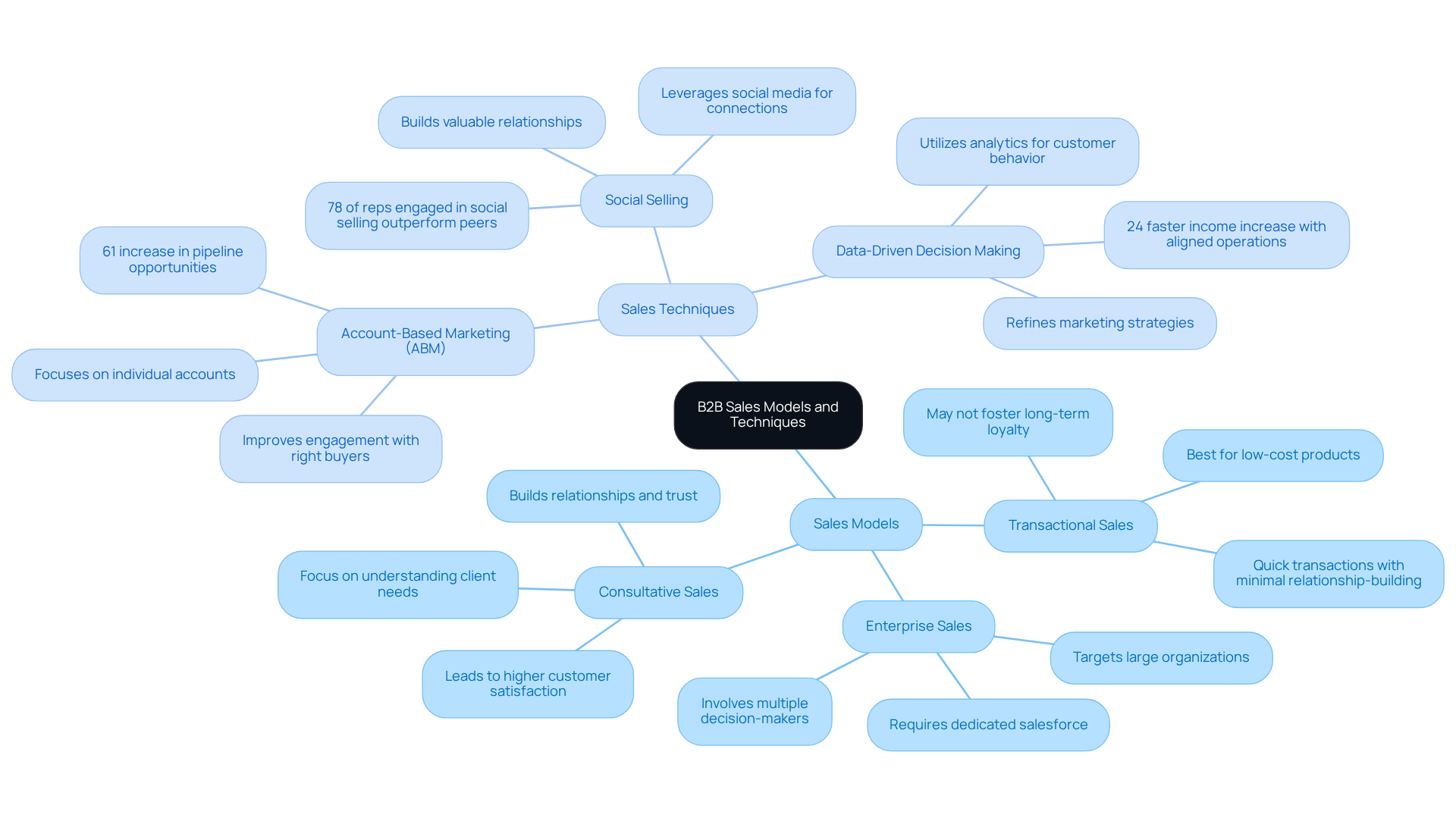Overview
Business to business (B2B) sales represent a unique journey where one company provides products or services to another. This process often involves longer sales cycles, higher transaction values, and intricate decision-making that engages multiple stakeholders. We understand that navigating these complexities can be daunting. That's why it’s essential to focus on building relationships and adopting tailored approaches in B2B sales.
Current trends highlight the integration of AI and the power of personalized content in shaping buyers' decisions. Imagine how much more impactful your outreach could be if it resonated deeply with your potential clients. By prioritizing relationship-building, you not only enhance your sales strategy but also foster trust and loyalty.
Together, we can explore how these insights can empower your business. Embrace the opportunity to connect with your audience on a personal level, and watch as your efforts lead to meaningful relationships and increased success.
Introduction
Understanding the dynamics of Business to Business (B2B) sales is essential in a marketplace where relationships and strategic partnerships truly drive growth. We recognize that navigating these complexities can be challenging for many businesses. This article explores the key characteristics, models, and techniques that define B2B transactions, shedding light on the intricate pathways to success.
As the sales landscape evolves rapidly, we invite you to consider:
- What strategies can your company employ to not only adapt but thrive in this intricate environment?
- Together, we can explore solutions that empower your business to flourish.
Define Business to Business Sales
What is business to business sales? It involves exchanges focused on connections, where one company provides products or services to another company instead of individual customers. This model is embraced across many sectors, including manufacturing, wholesale, and technology. To grasp what is business to business sales, it's important to understand that B2B transactions often involve larger values and longer cycles, requiring input from multiple decision-makers and a more intricate purchasing process. In fact, the typical B2B transaction cycle can last anywhere from one to three months, with some companies experiencing cycles that extend beyond five months due to the complexities involved in decision-making.
Current trends show that:
- 70% of B2B firms are now incorporating AI into their sales strategies, which can significantly enhance efficiency and effectiveness.
- 84% of B2B buyers start their purchasing journey with a referral, underscoring the importance of nurturing existing customer relationships.
- 90% of purchasers agree that online content plays a crucial role in their buying decisions.
Consider the impact of effective B2B selling techniques: for instance, Mack’s Truck Sales generated £1 million in revenue within just two months of implementing targeted sales tools. Similarly, CSI uncovered $2.5 million in inbound revenue in their first year by refining their selling processes. These examples serve as a reminder of what is business to business sales and highlight the importance for small business owners to understand the intricacies of B2B transactions. By implementing strategies that foster strong connections, you can simplify your selling efforts and pave the way for success. Together, we can navigate these challenges and achieve great results.

Explore the Evolution and Context of B2B Sales
The journey of what is business to business sales transactions is rooted in the foundational days of trade, where personal relationships and face-to-face interactions were paramount. As industries evolved and technology advanced, companies began to embrace more structured approaches, such as formal contracts and negotiations. The advent of the internet in the late 20th century revolutionized B2B transactions, enabling businesses to reach a broader audience and streamline their operations.
Today, understanding what is business to business sales involves digital marketing strategies, data-driven decision-making, and automation tools that empower companies to connect with prospects more effectively and efficiently. Did you know that 57% of the B2B buyer's journey is completed before a vendor is contacted? This highlights the importance of leveraging automation tools and buyer intent data to engage prospects meaningfully. Moreover, 75% of buyers prefer discovering products through tailored content rather than traditional marketing methods, underscoring the vital role of personalized content in today’s B2B landscape.
As we look ahead to 2025, the integration of advanced technologies, including AI, continues to reshape B2B transactions, enhancing efficiency and enabling businesses to meet the increasingly complex needs of their clients. However, it’s essential to recognize what is business to business sales, especially since the complexity of B2B transaction cycles has increased by 22% over the past five years, presenting challenges for sales teams who face an average annual turnover rate of about 34%. Together, we can navigate these challenges and find solutions that foster growth and success.

Identify Key Characteristics of B2B Sales
Key characteristics of B2B sales include:
-
Longer Sales Cycles: B2B transactions often involve extensive research and multiple stakeholders, leading to an average sales cycle length of 84 days. This complexity can feel overwhelming, but it’s important to know that organizations can adjust their strategies effectively. At Wayy.ai, we support small business owners by providing daily email updates that keep you informed about key metrics, helping you navigate these prolonged decision-making processes with confidence.
-
Higher Transaction Values: B2B exchanges usually entail larger amounts of money, with numerous transactions attaining substantial values due to bulk purchases or investments in high-value services. For instance, companies often engage in deals that can exceed millions of dollars, reflecting the significant financial stakes involved. Understanding this can empower you to approach these transactions with the right mindset.
-
Complex Decision-Making: The presence of multiple decision-makers and influencers complicates the transaction process. Research indicates that at companies with 100-500 employees, an average of seven people are involved in buying decisions. This necessitates tailored approaches to address diverse perspectives and needs. Wayy.ai's insights can help you identify key stakeholders and tailor your communications accordingly, ensuring everyone feels heard.
-
Relationship Building: Successful B2B transactions depend significantly on establishing and nurturing long-term connections with clients. As emphasized by industry experts, building trust and dependability is crucial, with 80% of B2B transactions influenced by personal endorsements and referrals. At Wayy.ai, we enhance this by tracking interactions and providing insights that help you nurture these connections, ultimately enhancing customer loyalty and satisfaction.
-
Tailoring: B2B offerings often necessitate adjustments to fulfill the particular requirements of various enterprises. This requires a consultative sales approach, where understanding customer requirements and preferences is crucial for delivering tailored solutions that resonate with clients. Notably, 60% of B2B buyers prefer companies that offer personalized recommendations based on their purchase history. Wayy.ai's data-driven method enables you to offer these tailored suggestions effectively, ensuring your clients feel valued.
By leveraging tools like Wayy.ai, you can streamline these processes. With features such as daily email updates that provide insights into key metrics—like how many leads were reached, who showed interest, and the conversion rate—you can improve your revenue performance. This data-driven approach allows for better tracking of leads and interests, ultimately supporting more effective decision-making and relationship management. Together, we can achieve success in navigating the complexities of B2B sales.

Examine B2B Sales Models and Techniques
B2B sales can be categorized into several models, each thoughtfully designed to meet diverse market needs:
- Transactional Sales: This model emphasizes quick transactions with minimal relationship-building, typically suited for low-cost products. While it allows businesses to close deals efficiently, it may not foster long-term customer loyalty.
- Consultative Sales: This approach centers on understanding the unique needs of clients and providing tailored solutions. It highlights the importance of building relationships, which is essential for nurturing trust and long-term partnerships. Many sales leaders emphasize that effective consultative selling can lead to higher customer satisfaction and retention rates. As one expert insightfully noted, "Sales is not about selling anymore, but about building trust and educating."
- Enterprise Sales: Targeting large organizations with complex needs, this model requires a dedicated salesforce and extended selling periods. It often involves multiple decision-makers, making relationship management crucial.
To enhance your B2B sales strategy, consider these effective techniques:
- Account-Based Marketing (ABM): This strategy focuses on individual accounts rather than a broad audience, allowing for personalized marketing efforts. Organizations utilizing ABM have reported a remarkable 61% increase in pipeline opportunities. Additionally, 61% of firms recognize that the primary advantage of ABM lies in improving pipeline opportunities, quality, or both, demonstrating its effectiveness in boosting revenue.
- Social Selling: By leveraging social media platforms to connect with potential clients, you can build valuable relationships and trust. Statistics reveal that 78% of representatives engaged in social selling surpass their colleagues who do not, and social selling leaders are 51% more likely to meet their targets.
- Data-Driven Decision Making: Utilizing analytics to understand customer behavior allows companies to refine their marketing strategies. Research indicates that organizations with coordinated marketing and revenue operations experience a 24% faster income increase over three years, underscoring the significance of data in driving sales success.
By embracing these models and techniques, small business owners can significantly enhance their outreach efforts and improve their sales outcomes. Remember, together we can navigate these challenges and achieve success.

Conclusion
As we conclude our exploration of business to business (B2B) sales, it’s essential to recognize its significance within the commercial landscape. These transactions, which occur between companies rather than individual consumers, highlight the importance of nurturing relationships and comprehending the intricacies of the purchasing process. With substantial financial stakes and multiple decision-makers involved, understanding the nuances of B2B sales is vital for businesses striving to thrive in a competitive environment.
We’ve discussed key characteristics such as:
- Longer sales cycles
- Higher transaction values
- The necessity of relationship building
The evolution of B2B sales practices, especially with the integration of technology and data-driven strategies, has transformed how businesses connect with one another. Techniques like account-based marketing and social selling have emerged as powerful tools, enhancing outreach and fostering trust—elements that are crucial for successful B2B transactions.
Ultimately, grasping what B2B sales entails and its inherent complexities is imperative for businesses looking to optimize their sales strategies. By embracing innovative approaches and nurturing connections, we can navigate the challenges of B2B sales more effectively. As the landscape continues to evolve, staying informed and adaptable will be key to achieving sustained success in this dynamic marketplace. Together, we can overcome these challenges and find pathways to success.
Frequently Asked Questions
What is business to business (B2B) sales?
Business to business sales involve exchanges where one company provides products or services to another company, rather than to individual customers. This model is common in sectors like manufacturing, wholesale, and technology.
How do B2B transactions differ from B2C transactions?
B2B transactions typically involve larger values and longer sales cycles, requiring input from multiple decision-makers and a more complex purchasing process.
What is the typical duration of a B2B transaction cycle?
The typical B2B transaction cycle can last from one to three months, with some cycles extending beyond five months due to the complexities involved in decision-making.
What are some current trends in B2B sales?
Current trends include that 70% of B2B firms are incorporating AI into their sales strategies, 84% of B2B buyers start their purchasing journey with a referral, and 90% of purchasers agree that online content plays a crucial role in their buying decisions.
Can you provide examples of successful B2B sales strategies?
Yes, for example, Mack’s Truck Sales generated £1 million in revenue within two months of implementing targeted sales tools, and CSI uncovered $2.5 million in inbound revenue in their first year by refining their selling processes.
Why is it important for small business owners to understand B2B sales?
Understanding the intricacies of B2B transactions is crucial for small business owners as it helps them implement strategies that foster strong connections, simplify selling efforts, and pave the way for success.




